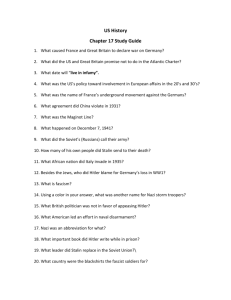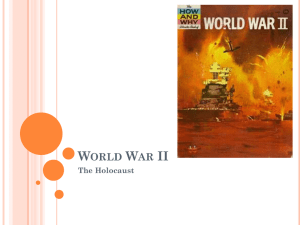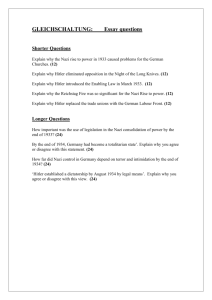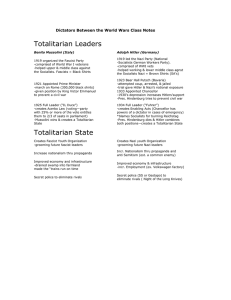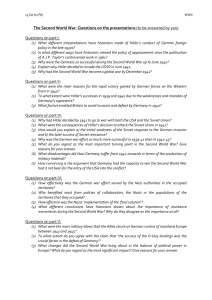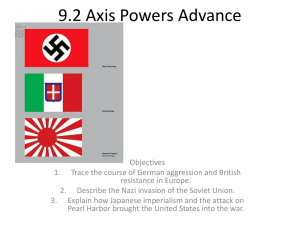Europe between the Wars: Teacher Answer Sheet
advertisement
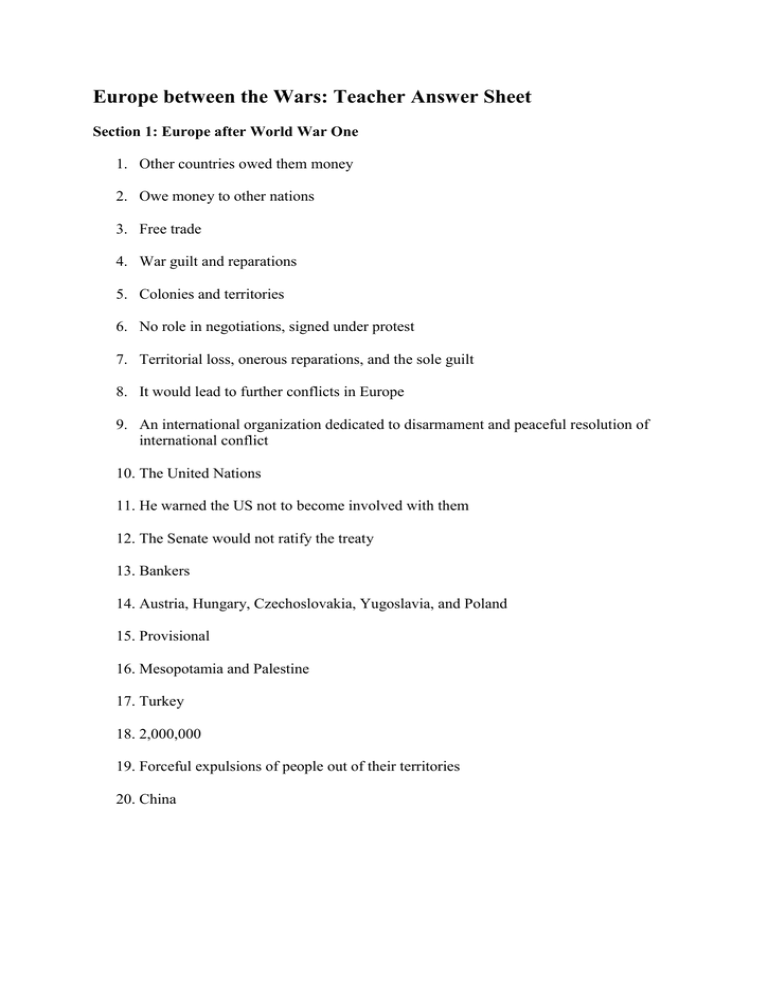
Europe between the Wars: Teacher Answer Sheet Section 1: Europe after World War One 1. Other countries owed them money 2. Owe money to other nations 3. Free trade 4. War guilt and reparations 5. Colonies and territories 6. No role in negotiations, signed under protest 7. Territorial loss, onerous reparations, and the sole guilt 8. It would lead to further conflicts in Europe 9. An international organization dedicated to disarmament and peaceful resolution of international conflict 10. The United Nations 11. He warned the US not to become involved with them 12. The Senate would not ratify the treaty 13. Bankers 14. Austria, Hungary, Czechoslovakia, Yugoslavia, and Poland 15. Provisional 16. Mesopotamia and Palestine 17. Turkey 18. 2,000,000 19. Forceful expulsions of people out of their territories 20. China Section 2: Russia goes Communist 1. The Romanov Dynasty 2. The Latin word Caesar. 3. They were executed in 1918 4. 80% of Russians were peasants 5. A form of slavery in which peasants were bound to large agricultural estates. 6. It had the largest factories in the world. 7. The Czar abdicated 8. The Bolsheviks 9. Food 10. Food and an end to the war 11. Lenin would end the war with Germany 12. The dictatorship of the proletariat, a small group of dedicated individuals 13. He nationalized industries and banned labor unions 14. Russian, Transcaucasian, Ukrainian and Byelorussian. 15. Landowners, conservatives, republicans and those opposed to the unfavorable treaty Lenin signed with Germany. 16. Leon Trotsky 17. Private enterprise became illegal. A major famine occurred 18. The International Committee for Russian Relief, America 19. Sailors of the Baltic Fleet as well as soldiers and civilians at Kronstadt. 20. Lenin thought it was the first step toward world-wide revolution; Trotsky thought the Russian Revolution needed a permanent world-wide revolution.; Stalin thought that the USSR should think about itself only. 21. Hungary and Bavaria 22. Secret police 2 23. Rule by one person, not limited by law, constitution or competing political interests. 24. The state regulates every aspect of social and personal life. 25. Five-year plans 26. Stalin, Mussolini and Hitler 27. He wanted them to become factory workers. 28. The Hunger Plague, felt most in the Ukraine 29. Forced labor 30. A city of giant steel works 31. They confessed to crimes against the state and were executed. 32. John Dewey 33. A Soviet dissident writer 34. 30,000 35. 8.5 million arrests, one million executions 36. A system of forced labor camps for political and other prisoners. 37. It increase 6.5 times Fascist Italy 1. It is derived from the fasces, a symbol of power in ancient Rome 2. The ancient Roman Empire 3. The socialists and communists 4. The economy is controlled by elected councils representing each economic sector (labor, industry, agriculture, etc.). 5. National Fascist Party 6. Nationalist and anti-communist, corporatist economics, restore Italy’s prestige by building a new Roman Empire through colonial expansion in North Africa and the Adriatic. 7. King Victor Emmanuel III 8. Left parliament in protest 3 9. Non-fascist political parties were banned 10. Italy’s invasion of Abyssinia Europe between the wars 1. The stock market crash of 1929 2. The US demanded repayment from France and Great Britain; France and Great Britain demanded repayment from Germany; Germany needed loans form the US to support its economy 3. 13% 4. Coal miners 5. Artists, musicians, sculptors, dancers and writers 6. The “Lost Generation” 7. America 8. A slow paralysis compared to a cataclysmic collapse 9. French communists, socialists and other left-leaning groups 10. The middle class 11. It was less industrialized 12. General Francisco Franco 13. They became more authoritarian 14. They had opted out of the international capitalist system 15. It is an influential cultural movement self-consciously revolutionary, featured automatic painting and writing, and strongly referenced the unconscious mind. Nazi’s take over in Germany 1. Weimer Republic 2. Bauhaus School 3. The Ruhr Valley, France and Belgium sent troops in to take control of it after Germany defaulted on its reparations 4. Printed too much money 4 5. 100,000,000,000 = One hundred billion times 6. It created a new schedule of payments, returned the Ruhr industrial zone, and provided massive loans from the US 7. An end to reparation payments and a rejection of the War Guilt clause 8. Extreme right and left wing 9. He supported the militarist and anti-Semitic policies 10. They felt it was derogatory 11. A paramilitary arm of the Nazi party made up (at first) of ex-army storm troopers. 12. It was a symbol from Troy; it was the symbol of the “Aryan race”. 13. It was a call for more land and territory (colonies) for Germany. 14. Hitler’s failed coup d’état in Munich. 15. Hitler’s political manifesto 16. The Nazi’s gained power while the Social Democrats lost power. 17. Intimidation from the Nazi’s 18. The communists 19. President of the Weimar Republic 20. Second in command of the Third Reich. 21. Minister for Public Enlightenment and Propaganda 22. Head of the SS and the Gestapo, also the director of the concentration camps. 23. The only German institution not under Hitler’s control. Limited by treaty to 100,000 troops. 24. The paramilitary wing of the Nazi party, by 1934 it numbered more than 4 million. 25. An Elite group within the SA, led by Heinrich Himmler 26. The German secret state police 27. Leaders of the SA and others disloyal to Hitler were executed 28. Forced labor, imprisonment, and extermination. 5 29. Many Jewish civil-service employees, including teachers and judges, removed. 30. Jews could not act as newspaper editors. 31. Voting rights, civil employment, marriage between Jews and non-Jews, sex between Jews and non-Jews, Jewish children could not use non-Jewish playgrounds 32. “The Laws for the Protection of German Blood and German Honor.” 33. Kristallnacht 34. Six million 35. Jesse Owens, an African American 36. Marc Chagall, Pablo Picasso and Vincent van Gogh, Degenerate and subversive. Spanish Civil War and Collapse of the Versailles Treaty 1. The Nationalists, included large landowners, the Catholic church, and other anticommunist elements. 2. The Republicans (also called Loyalists), included liberals, anarchists, socialists and communists. 3. Nazi Germany, Fascist Italy, and Portugal 4. Soviet Union and Mexico 5. The US, France, and Great Britain 6. George Orwell 7. Intense bombing of civilian populations 8. Established a German air force. Sent troops into the Rhineland. The annexation of Austria. The Munich Agreement. Invasion of Czechoslovakia. The Nazi-Soviet Nonaggression Pact. Invasion of Poland. 9. Czechoslovakia 10. Germany, France, Great Britain and Italy 6 11. The policy of granting gifts or concessions to secure peace, is today a derogatory term often associated with the Munich Agreement 12. Germany and the Soviets would divide Europe into German and Soviet spheres of influence 13. Poland 14. Germany invaded the Soviet Union 7

